DuckDB -- ART索引
DuckDB不同于其他的数据库,并没有使用B+树作为主要索引结构,而是使用了ART(Adaptive Radix Tree)作为它内部的主要索引结构。本文将介绍这一索引
ART(Adaptive Radix Tree)
ART 索引是由Viktor Leis, Alfons Kemper, Thomas Neumann等人提出,它相比于B+数的主要区别在于B+树是面向磁盘的,而ART则是面向内存的。即ART索引是需要全部加载到内存中的。DuckDB之所以选择这个索引有以下几方面的考虑
- 随着内存越来越大,并且价格也越来越便宜,我们可以使用纯内存的索引,从而避免磁盘IO,提升性能。
- ART索引可以很大程度上的节省空间。
- ART索引支持范围查询。
- ART索引有着较高的性能。
后续本文会先介绍ART这一数据结构,然后配合着DuckDB的代码描述ART是如何实现的。
数据结构
在讲ART索引之前,我们先看一下Trie树。(如果你不知道Trie树,可以参考Trie )

我们可以看到Trie树在检索时的优点是,它的检索时间仅与最长的字符串长度有关,而与存储的字符数量无关,这一特性在数据量极大的情况下十分优秀。但是它的缺点是浪费空间,即每个内部节点都需要保存固定数量的指针,即使它仅有极少的子结点。
比如图中的root节点,尽管他只有三个子结点,但是它仍然需要保存指向a,c,e...的空指针。这十分浪费空间。其次Trie树仅支持保存字符串。
ART则是在Trie树的基础上,解决了它缺点的同时,保留了它的优点。下面我们来介绍ART索引。
对于一个索引而言,我们希望它有以下两个特点
- 查询速度快
- 空间占用小
但是如果我们使用Trie树做索引(ART是Trie的一个变种),我们就要面临取舍,如果内部节点可以拥有的最大子结点越多(空间占据越多),那么它的高度也越低(速度越快)。如果内部节点拥有的最大子结点越少(空间占据越少),那么他的高度也越高(速度越慢)。
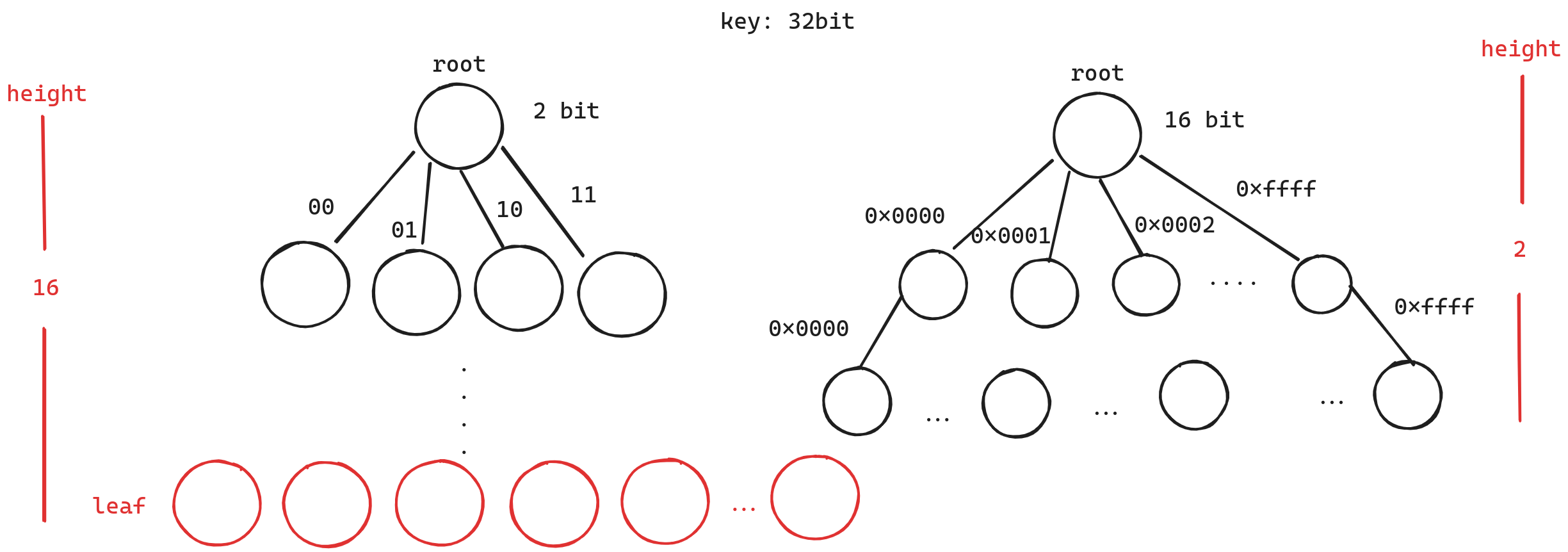
ART树选择每个内部节点的大小为8bit(子结点的数量为256),刚好是一个byte。这样的好处是免去了内存对齐的问题,同时在空间与速度上取得了一个较好的平衡。我们称内部节点所占据的位宽为span.
尽管如此,面对稀疏的数据时,每个节点有256个子结点仍旧会浪费空间,为了解决这个问题。ART将内部节点进一步细分为以下四类, 我们分别来对其进行介绍。
- Node4
- Node16
- Node48
- Node256
Node4
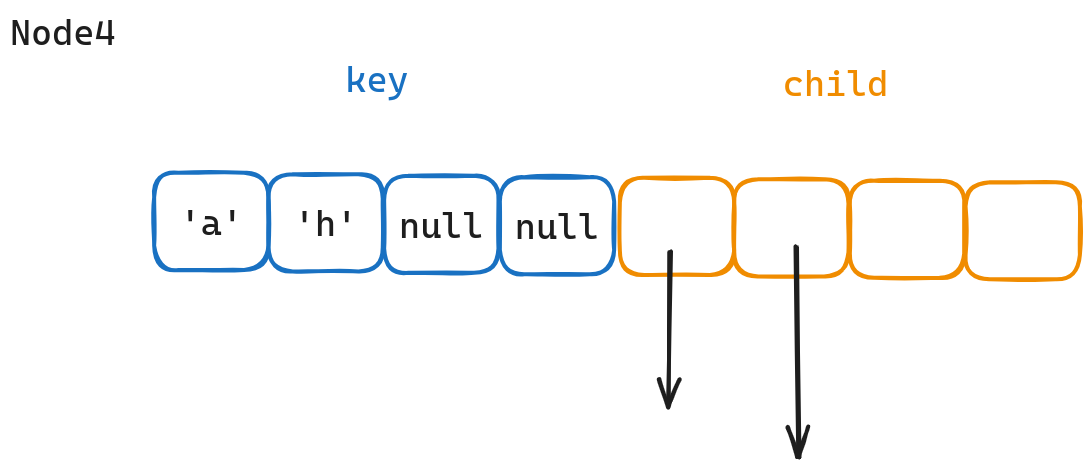
从图中可以看出,Node4分为两个部分,一个是key数组,一个是child数组。key数组存放key的部分内容(也就是key的一个byte),child数组则是保存对应的子结点的指针。注意,我们为了可以范围查询,key数组要求顺序存储。
Node16
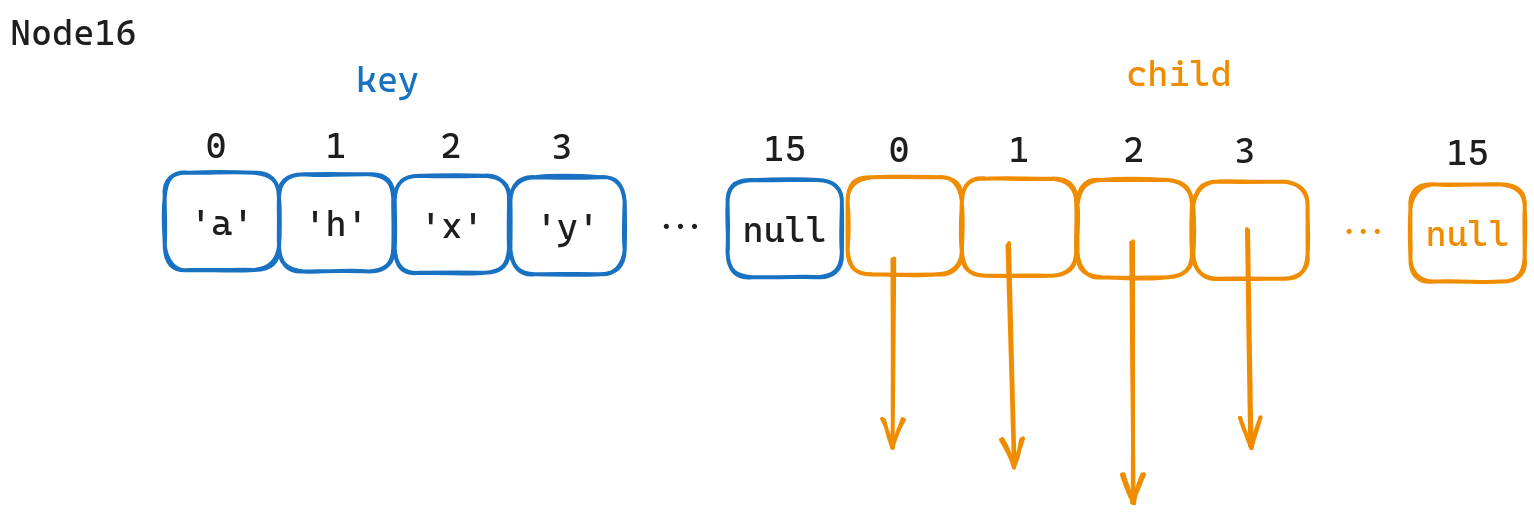
Node16和Node4几乎一样,区别只是从4个slot变为16个slot
Node48

Node48和之前介绍的Node一样也是分为key数组和child数组,区别在于Node48的key数组长度为256,这样子我们就无须通过遍历找到对应的数组,而是可以直接通过key的二进制值作为下标直接定位到对应的key slot。key slot中存放的是指针,指向对应的子结点在child数组中的位置。因此child数组的长度仅需要48就可以了。
实际查询仅需要child_array[key_array[key]]即可。
Node256

Node256就是Trie树原始的内部节点表示形式,仅需要一个数组,数组的下标即为key,数组中存放的就是子结点的指针。
各种不同类型的Node可以相互转换,如果子结点数量超过限制容量就向上转换,如果节点数量相较于限制容量太小就向下转换。
Leaf
ART中的叶节点存放的就是Key对应的Value值 ART的叶节点可以采用三种形式
- 单独有一个叶节点类型专门保存Value
- 和中间节点保持一致的类型,唯一区别则是child数组不保存指针而是值
- 如果值足够小可以通过位操作和指针一起保存,那么我们可以将值直接存放在内部节点中。
DuckDB采用的是第一种方式。
优化
在解决了ART的空间问题,我们希望可i进一步优化查询速度,即减少树的高度。论文中有两种方式,但实际上我们可以通过一种简单的做法同时获得这两种优化,每个节点加上Prefix标识。
- lazy expansion
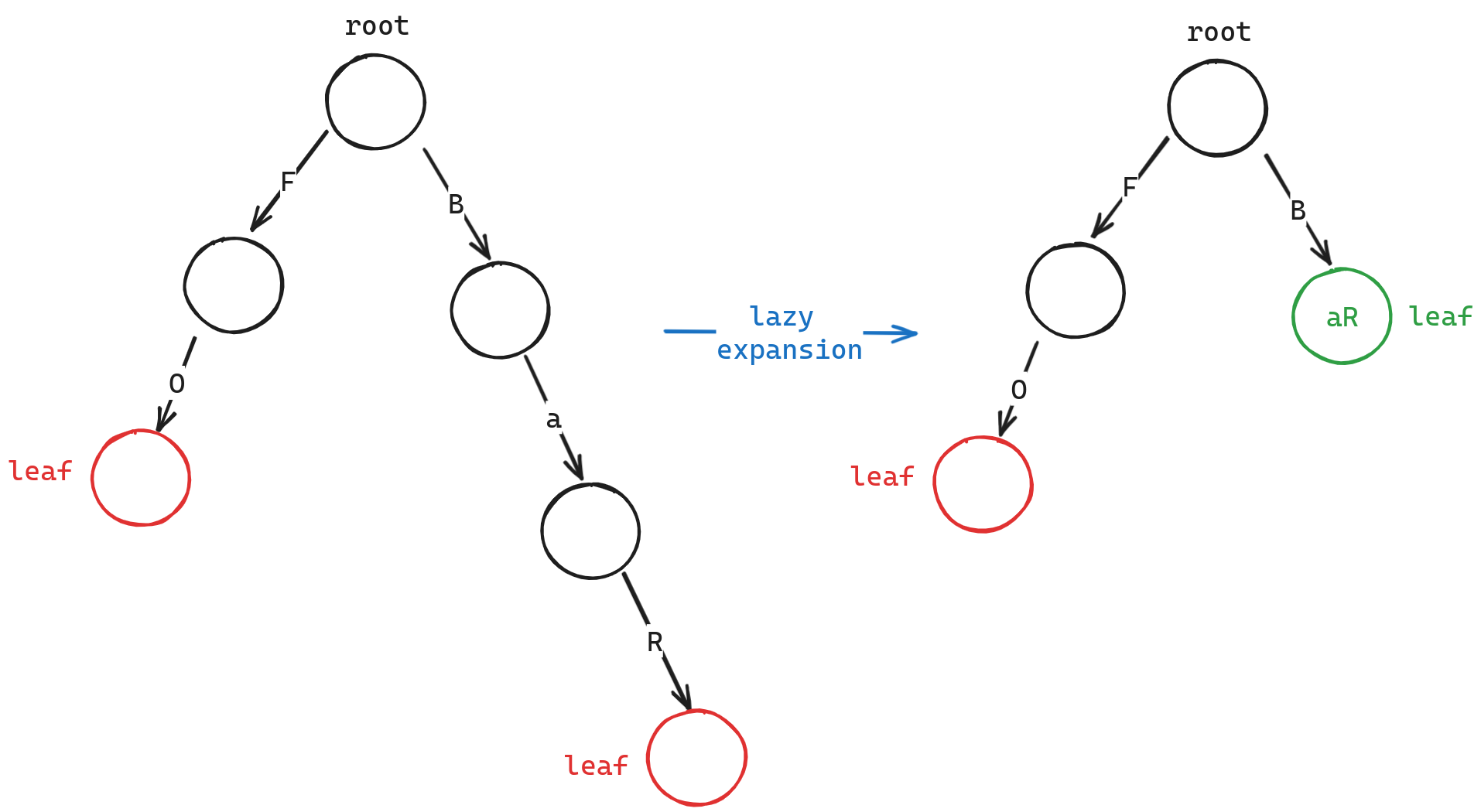
其实这个优化相当简单,我们只需Leaf可以保存多个byte即可,这样子对于多个只有一个子结点的路径来说,我们可以将其都保存在Leaf中,从而减少树的高度。
- path compression
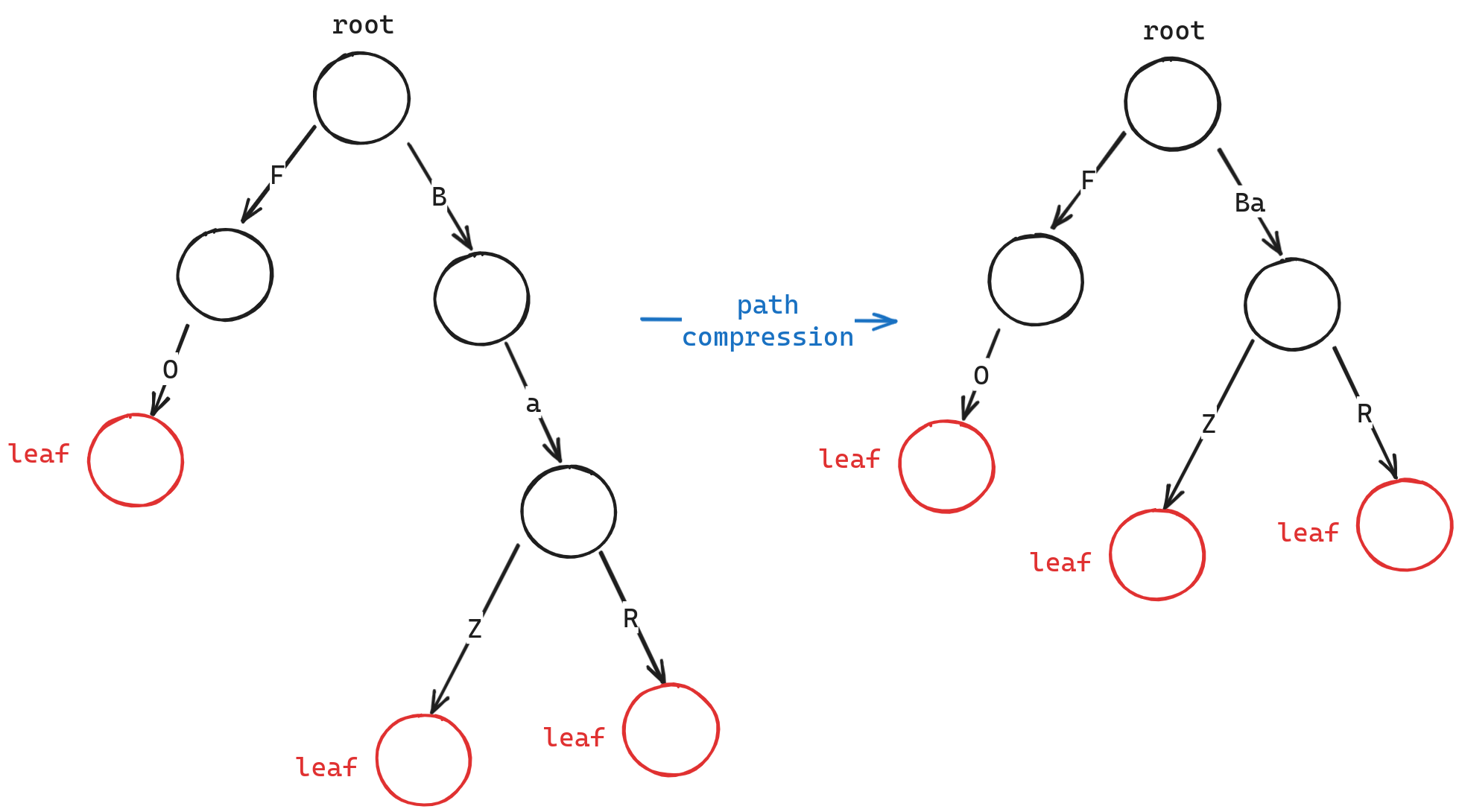
这个优化和lazy expansion类似,我们只需让内部节点可以保存多个byte即可。即如果内部节点有相同的前缀,我们可以将其保存在Prefix中,key数组仅仅只对key不同的部分作区分。这样子也可以有效的减少树的高度。
如果这里没看懂也没关系,后续我们会分析DuckDB的代码,那样会更加清晰。
数据转换
对于ART来说,我们前面介绍的都是对于字符串类型,如果作为一个被广泛使用的索引,那我们也需要支持不同类型的数据。而ART索引实际上是把Key作为数据流进行处理的,也就是说如果想要通过ART进行范围搜索,我们需要让Key保持一个性质,即二进制的大小与该类型的语义大小相同。即
因此我们需要对某些数字进行转换
-
unsigned integers
无需转化,已经满足需求。
-
signed integers
将符号位flip即可
-
Floating Point Numbers
static inline uint32_t EncodeFloat(float x) { uint64_t buff; //! zero if (x == 0) { buff = 0; buff |= (1u << 31); return buff; } // nan if (Value::IsNan(x)) { return UINT_MAX; } //! infinity if (x > FLT_MAX) { return UINT_MAX - 1; } //! -infinity if (x < -FLT_MAX) { return 0; } buff = Load<uint32_t>(const_data_ptr_cast(&x)); if ((buff & (1u << 31)) == 0) { //! +0 and positive numbers buff |= (1u << 31); } else { //! negative numbers buff = ~buff; //! complement 1 } return buff; } -
Character Strings
UCA算法已经做出了定义
-
Null
我们可以将该值设置为比最大位数仍多1位。
-
Compound Keys
按照其包含的基本类型进行拼接即可
源码解析
这一章节我们通过阅读DuckDB的源码,来看一下ART索引的实现。
ART索引的相关实现都在art.cpp和art.hpp,我们主要关注Insert和Find, 其他的函数留给读者自行了解。
Insert
bool ART::Insert(Node &node, const ARTKey &key, idx_t depth, const row_t &row_id) {
if (!node.IsSet()) {
// node is currently empty, create a leaf here with the key
Leaf::New(*this, node, key, depth, row_id);
return true;
}
if (node.DecodeARTNodeType() == NType::LEAF) {
// add a row ID to a leaf, if they have the same key
auto &leaf = Leaf::Get(*this, node);
auto mismatch_position = leaf.prefix.KeyMismatchPosition(*this, key, depth);
// identical equal
if (mismatch_position == leaf.prefix.count && depth + leaf.prefix.count == key.len) {
return InsertToLeaf(node, row_id);
}
// example:
// prefix : hello
// key[depth] : heel;
// mismatch_position = 2
// replace leaf with Node4 and store both leaves in it
auto old_node = node;
auto &new_n4 = Node4::New(*this, node);
// new prefix
// new_n4's prefix is he
new_n4.prefix.Initialize(*this, key, depth, mismatch_position);
// old_node's prefix change to llo
auto key_byte = old_node.GetPrefix(*this).Reduce(*this, mismatch_position);
// add child
Node4::InsertChild(*this, node, key_byte, old_node);
Node leaf_node;
Leaf::New(*this, leaf_node, key, depth + mismatch_position + 1, row_id);
// add child
Node4::InsertChild(*this, node, key[depth + mismatch_position], leaf_node);
return true;
}
// handle prefix of inner node
auto &old_node_prefix = node.GetPrefix(*this);
if (old_node_prefix.count) {
auto mismatch_position = old_node_prefix.KeyMismatchPosition(*this, key, depth);
if (mismatch_position != old_node_prefix.count) {
// prefix differs, create new node
auto old_node = node;
auto &new_n4 = Node4::New(*this, node);
new_n4.prefix.Initialize(*this, key, depth, mismatch_position);
auto key_byte = old_node_prefix.Reduce(*this, mismatch_position);
Node4::InsertChild(*this, node, key_byte, old_node);
Node leaf_node;
Leaf::New(*this, leaf_node, key, depth + mismatch_position + 1, row_id);
Node4::InsertChild(*this, node, key[depth + mismatch_position], leaf_node);
return true;
}
depth += node.GetPrefix(*this).count;
}
// recurse
D_ASSERT(depth < key.len);
auto child = node.GetChild(*this, key[depth]);
if (child) {
bool success = Insert(*child, key, depth + 1, row_id);
node.ReplaceChild(*this, key[depth], *child);
return success;
}
// insert at position
Node leaf_node;
Leaf::New(*this, leaf_node, key, depth + 1, row_id);
Node::InsertChild(*this, node, key[depth], leaf_node);
return true;
}代码还是比较多的,我们先介绍一下参数的意义
-
node 即为当前要进行插入的节点.
-
key 即为要插入的key
-
depth
即当前已经处理到key的第几个byte,举个例子,key为
hello, depth为3,那么说明he已经保存在了node的祖先节点中,我们当前要处理的是l。 -
row_id 即为key对应的value值.
bool ART::Insert(Node &node, const ARTKey &key, idx_t depth, const row_t &row_id) {
if (!node.IsSet()) {
// node is currently empty, create a leaf here with the key
Leaf::New(*this, node, key, depth, row_id);
return true;
}
}如果当前节点为空,那么直接设置该节点为叶节点,并且将row_id进行保存,注意这里我们会使用lazy-expansion, 即将key剩余未处理的字符全部保存在叶节点中。
bool ART::Insert(Node &node, const ARTKey &key, idx_t depth, const row_t &row_id) {
// .... skip
if (node.DecodeARTNodeType() == NType::LEAF) {
// add a row ID to a leaf, if they have the same key
auto &leaf = Leaf::Get(*this, node);
auto mismatch_position = leaf.prefix.KeyMismatchPosition(*this, key, depth);
// identical equal
if (mismatch_position == leaf.prefix.count && depth + leaf.prefix.count == key.len) {
return InsertToLeaf(node, row_id);
}
// example:
// prefix : hello
// key[depth] : heel;
// mismatch_position = 2
// replace leaf with Node4 and store both leaves in it
auto old_node = node;
auto &new_n4 = Node4::New(*this, node);
// new prefix
// new_n4's prefix is he
new_n4.prefix.Initialize(*this, key, depth, mismatch_position);
// old_node's prefix change to llo
auto key_byte = old_node.GetPrefix(*this).Reduce(*this, mismatch_position);
// add child
Node4::InsertChild(*this, node, key_byte, old_node);
Node leaf_node;
Leaf::New(*this, leaf_node, key, depth + mismatch_position + 1, row_id);
// add child
Node4::InsertChild(*this, node, key[depth + mismatch_position], leaf_node);
return true;
}
//skip....
}如果当前遇到的是叶节点,同时key完全相同,那么我们可以直接将row_id插入叶节点中。不然的话,我们需要将叶节点变为内部节点,同时将不同的部分作为该内部节点的叶节点。如下图所示。

bool ART::Insert(Node &node, const ARTKey &key, idx_t depth, const row_t &row_id) {
// skip ....
// handle prefix of inner node
auto &old_node_prefix = node.GetPrefix(*this);
if (old_node_prefix.count) {
auto mismatch_position = old_node_prefix.KeyMismatchPosition(*this, key, depth);
if (mismatch_position != old_node_prefix.count) {
// prefix differs, create new node
auto old_node = node;
auto &new_n4 = Node4::New(*this, node);
new_n4.prefix.Initialize(*this, key, depth, mismatch_position);
auto key_byte = old_node_prefix.Reduce(*this, mismatch_position);
Node4::InsertChild(*this, node, key_byte, old_node);
Node leaf_node;
Leaf::New(*this, leaf_node, key, depth + mismatch_position + 1, row_id);
Node4::InsertChild(*this, node, key[depth + mismatch_position], leaf_node);
return true;
}
depth += node.GetPrefix(*this).count;
}
// recurse
D_ASSERT(depth < key.len);
auto child = node.GetChild(*this, key[depth]);
if (child) {
bool success = Insert(*child, key, depth + 1, row_id);
node.ReplaceChild(*this, key[depth], *child);
return success;
}
// insert at position
Node leaf_node;
Leaf::New(*this, leaf_node, key, depth + 1, row_id);
Node::InsertChild(*this, node, key[depth], leaf_node);
return true;
}如果是内部节点,那我们需要讨论
- 如果前缀完全相同,即“hello”和”hellopxxx“。那么我们仅需要找出子结点进行插入即可。如下图所示。

- 如果前缀有不同指出,那么我们需要创建一个新的节点。并将两个节点作为子结点进行插入。如下图所示。

可以看到,我们只需要在内部节点,和叶节点中支持存储多个字符后,便天然支持上述的有化方案。
Find
Node ART::Lookup(Node node, const ARTKey &key, idx_t depth) {
while (node.IsSet()) {
if (node.DecodeARTNodeType() == NType::LEAF) {
auto &leaf = Leaf::Get(*this, node);
// check if leaf contains key
for (idx_t i = 0; i < leaf.prefix.count; i++) {
if (leaf.prefix.GetByte(*this, i) != key[i + depth]) {
return Node();
}
}
return node;
}
auto &node_prefix = node.GetPrefix(*this);
if (node_prefix.count) {
for (idx_t pos = 0; pos < node_prefix.count; pos++) {
if (key[depth + pos] != node_prefix.GetByte(*this, pos)) {
// prefix mismatch, subtree of node does not contain key
return Node();
}
}
depth += node_prefix.count;
}
// prefix matches key, but no child at byte, does not contain key
auto child = node.GetChild(*this, key[depth]);
if (!child) {
return Node();
}
// recurse into child
node = *child;
D_ASSERT(node.IsSet());
depth++;
}
return Node();
}查找的代码相对来说比较简单
- 查找到了
Leaf节点,检查Prefix是否匹配。如果不匹配说明Key不存在,若匹配直接返回该叶节点即可。 - 查找到了
内部节点,检查Prefix是否匹配。如果不匹配说明Key不存在,若匹配继续搜索对应的子节点。
Last
本文介绍了DuckDB的ART索引,可以看到尽管ART索引的树会比B+树更高,因此如果是面向磁盘的情况下,B+树会比ART索引优势更大,但是如果是内存索引的情况下,ART索引更加紧凑,同时他的渐进时间复杂度仅与key的长度有关,可能也更加cache friendly?它的节点相较于B+树更加的小,可以更多的保存在cache中。从论文中的实验来看,它的性能会比B+树更好。相较于Hash table,它支持范围查询。基于此DuckDB将ART索引作为其的主要索引。